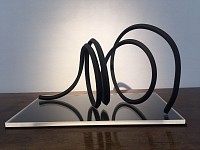BIOGRAPHY

BRENDON EDWARDS
(b.1970, Johannesburg, South Africa)
Brendon Edwards was born in Johannesburg in 1970, but spent his formative years in Zimbabwe. He later moved to South Africa and was educated at Michaelhouse.
Post school he studied Philosophy and Logic, and The Philosophy of Aesthetics. His work is a continuation along these lines and a conflation of latter influences. An overriding aim of his work is to take complicated subjects (both visible and invisible) and represent them as a simple aesthetic.
As an abstract artist, he is reluctant to reduce, explain or justify his work in absolute terms. He recognises that the world is devoid of meaning, and that any meaning individuals attach to a thing, experience or idea… is subjective. Consequently, any absolutes he may propound, may limit or exaggerate his work, or do an injustice to it, and further to the imagination/meaning of the viewer. There is a corollary in abstraction as within our universe, in that it leaves the unexplained… unexplained. Notwithstanding, discussed below are some thoughts and influences of his work.
PHILOSOPHY AND FORMS
The early Greek philosophers (notably, Pythagoras) and latter philosophers such as Hegel, Joseph Margoilis, Richard Rorty, Daniel Dennet, Isaiah Berlin, Stephen Hawkins and Nietzsche’s (Theory of Eternal Recurrence) have all had a critical influence on his work. The works of Pythagoras and Phidias (Greek sculptor and mathematician whom Phi is named after), were arguably the first to work with the Golden Ratio. Later Luca Pacioli (in collaboration with Da Vinci) wrote The Divine Proportion. It was here that the influences of the golden section, spheres, circles and arcs further influenced his work.
CIRCLES, SPHERES AND ARCS
Spheres, Circles and Arcs are ubiquitous in human history (in both primitive and modern man), and in everyday experience (both emotively and intellectually). The very instruments with which we perceive our physical world (our eyes) are circular, as are the images - the moon, the sun, the planets, the stars and the many revolutions of time, seasons, and life itself. Our intuitive language is spoken within a circular reference. Furthermore, the shape of the circle is known to represent infinity, completeness, inclusivity, whole, unity and perfection. It is also the symbol for both male and female. Accordingly, Leonardo da Vinci and Dr. Carl Jung's viewed the circle as a geometric archetype of the psyche… it explains the relationship or balance between psyche and body. In Art, the circle when depicted as a symbol draws the viewer into a work and includes the viewer in the experience. For Brendon circles, spheres and arcs are salient and intuitive shapes within any sculptural form.
SOUND AS A FORM
Pythagoras further explored the mathematical and spatial relationships found in music. The octaves in music can be represented visibly by the space between objects, and concomitantly the dark and light between those intervals in a sculpture. Brendon purports that the silence between musical notes is critical, as are the spaces between objects in sculpture. Space and voids are critical to his work as this creates the serenity and tension in a composition. Also, many of the images found in Cymasonic Theory and Quantum Theory have also influenced the geometric forms of his work.
WABI AND POETRY
Wabi is both an aesthetic and way of life. It is not a religion. It celebrates the beauty of imperfection and realises the transience of all things. “It is timeless, without a past, present or future….it is emptiness, silence and freedom. It’s a refined simplicity and purity”. This philosophy as well as poetry have influenced the material (such as the rusting of steel or the patina of copper) and simplicity with which Brendon creates his forms. Leonard Cohen said “there is a crack in everything and that’s how the light gets in” and before him Hemingway said “we are all broken and that’s how the light gets in”. Brendon acknowledges, like Wabi and the aforementioned poets, that there is something beautiful that time does to us, our buildings, and our imperfections if we surrender ourselves to them. We need to celebrate the imperfection, fragility and transience of our lives. The aim of his work is for it to transend through the process of time.
Since working with large scale steel and copper he has completed large scale installations throughout South Africa in both public, corporate and private spaces. He has recently completely smaller scale works.



